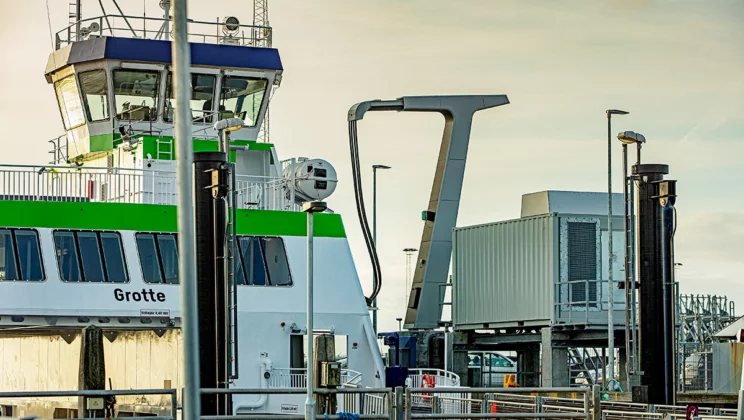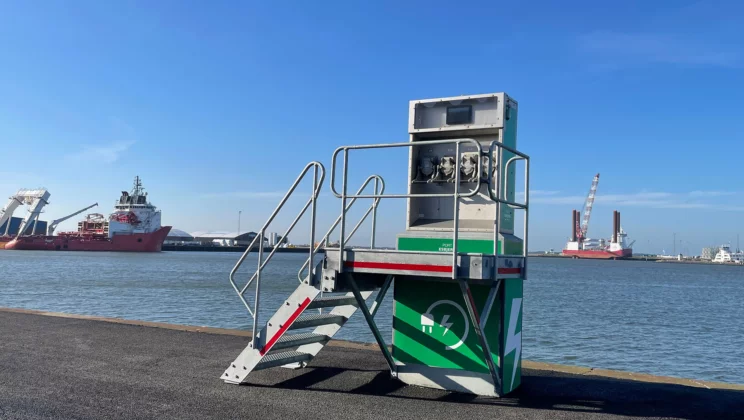Since January, vessels calling at the port of Esbjerg have been able to connect to shore-to-ship power, and more and more companies at the port are becoming wise to the benefits of turning off the generator and using green wind energy instead. Shore-to-ship power is cheaper and generates much less noise and carbon dioxide and particle emissions.
When calling at the ferry terminal at the port of Esbjerg, the new electrically powered Fanø ferry, Grotte, is automatically connected to the port’s shore-to-ship power plant supplying entirely green energy from the wind turbines off the coast, while passengers disembark and embark.
But Fanølinjen is far from the only customer at the port of Esbjerg to embrace shore-to-ship power. In January, the two large turbine installation vessels, Sea Challenger and Sea Installer, were connected at the Gemini Quay, followed by the Maersk Resolute drilling rig at the North Harbour and Havila Shipping’s vessels at the South Harbour.
Rasmus Ager, strategic project manager and in charge of shore-to-ship power at the port of Esbjerg, gives us a guided tour of the harbour in one of the port office’s cars – entirely electric, of course. He points out the distinctive green containers holding shore-to-ship power transformers that are now found all over the harbour.
“Our shore-to-ship power plant basically channels renewable energy from offshore wind turbines to the vessels so that ship owners don’t have to rely on generators while docked. This obviously leads to fuel savings and reduced carbon emissions, but also means that seamen and dock workers are exposed to less noise and particle pollution,” he explains and adds:
“Shore-to-ship power is now up and running, and new plants are added all the time. And to ensure that the new initiative gets noticed, we’ve painted them green – of course!”
The strategy seems to be working. More and more companies operating at the port request shore-to-ship power, and the port has so far installed plants at the Dock and the South Harbour as well as plants accommodating large turbine installation vessels and drilling rigs at the North Harbour. And new plants are added all the time.

Since 1 October, Grotte, the electric ferry, has had its batteries recharged with green power while passengers disembark and embark.
Power for small and big vessels alike
Rasmus Ager heads towards the Dock at the North Harbour where gigantic rigs and turbine installation vessels tower like high-rise apartment blocks. Drilling rigs and installation vessels often dock for prolonged periods of time while projects are being prepared. The ships work as floating hotels for technicians, engineers and seamen, and that takes a good deal of electricity.
According to Ager, the ships consume up to 10 MW, corresponding to the total consumption of 20,000 households. All that power is now entirely provided by renewable energy, for the benefit of the climate, the local community and the ship owners’ budgets. And large vessels are not the only ones to take advantage of shore-to-ship power, he explains while heading towards the Fanø ferry terminal.
Since 1 October, Grotte, the electric ferry, has had its batteries recharged with green power while passengers disembark and embark, explains Hans-Henrik Simonsen, COO at Molslinjen, which runs Fanølinjen:
“If we’re to realise our ambitious targets for reducing ferry carbon emissions, electrically powered vessels are an important part of the solution. But in order for that to happen, we need to be able to recharge our ferries’ batteries easily and efficiently, and the automatic plant at the ferry terminal enables us to do just that. At the same time, crews are exposed to less noise and heat from the engine.”
While Grotte runs entirely on green electricity, the two other ferries sailing on the route have switched to fossil-free biofuel, which has reduced total emissions from the three ferries by up to 96%.

Green shore-to-ship power plants provide vessels with green energy. Photo: Port Esbjerg
The port counts every kWh
Back at the port office, Ager is able to monitor the entire port’s consumption of electricity from his computer as all the green shore-to-ship power plants are connected to the port’s resource management system developed in a unique partnership with Honeywell, the world leader in infrastructure digitalisation and management.
“The main idea of digitalising our supply chain is to save resources. When all electricity consumption at the port is monitored in real time, we’re able to identify any waste of resources much faster. If we identify inappropriate consumption somewhere, we can take optimising action, which obviously benefits both the port and the port’s users,” he explains.
The solution of compiling the data from all consumption points at the port into one digital resource management system is a global first. No other port has invested so massively in compiling data on everything from vessels, infrastructure and various kinds of businesses operating at the port into one system. According to the project manager, this produces substantial benefits for day-to-day operations as well.
“When more and more links in the chain are in place, processes become easier. Looking ahead, we’ll be able to automatically keep an eye on everything from charging our electric cars with shore-to-ship power to monitoring water and heating consumption. This makes consumption transparent, and eventually we’ll be able to automatically draw up an invoice and a statement of how much CO2 the port and its users have saved”, he explains.
In the slightly longer term, the port’s water and heating consumption will be integrated into the system as well. Eventually, solar panels, large battery systems and Power-to-X may also be integrated in order to utilise the green power as efficiently as possible. Concurrently, carbon emissions are monitored in order to enable the port to document its progress on its ambitious target of being climate-neutral by 2030.
Investing in tomorrow’s green maritime sector
The investments in both physical and digital infrastructure are financed entirely by the port, as it is imperative that the project is viable not only in terms of supporting the sustainability measures at the port but also commercially.
“If we want to speed up the green transition of the maritime sector, it’s not enough that new measures are green. They also need to make financial sense. And shore-to-ship power does just that. We don’t want costs that’ll ultimately end up with our customers. The beauty is that shore-to-ship power enables us to save both CO2 and money,” explains Jesper Bank, CCO at Port Esbjerg.
Accordingly, the project is also about helping the port’s customers monitor, reduce and document their progress towards fossil-free shipping.
“The entire maritime sector will undergo a dramatic transition over the next few years. It’s crucial that technology and green fuels drive the transition in a way that can be documented and makes financial sense. With measures such as shore-to-ship power, Port Esbjerg is a forefront technology leader. And that’s just the beginning,” says Bank.
After an eight-minute stop at the ferry terminal, the Fanø ferry is ready for departure. As with an electric car, the engine is silent, and you only hear the stern breaking the waves. Maybe that is the sound of a greener future for the maritime sector with more and more activities going electric. At Esbjerg, they are well under way unleashing the potential.
Go to overview

